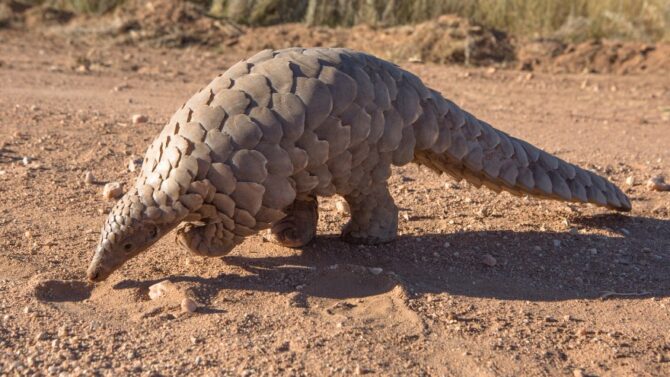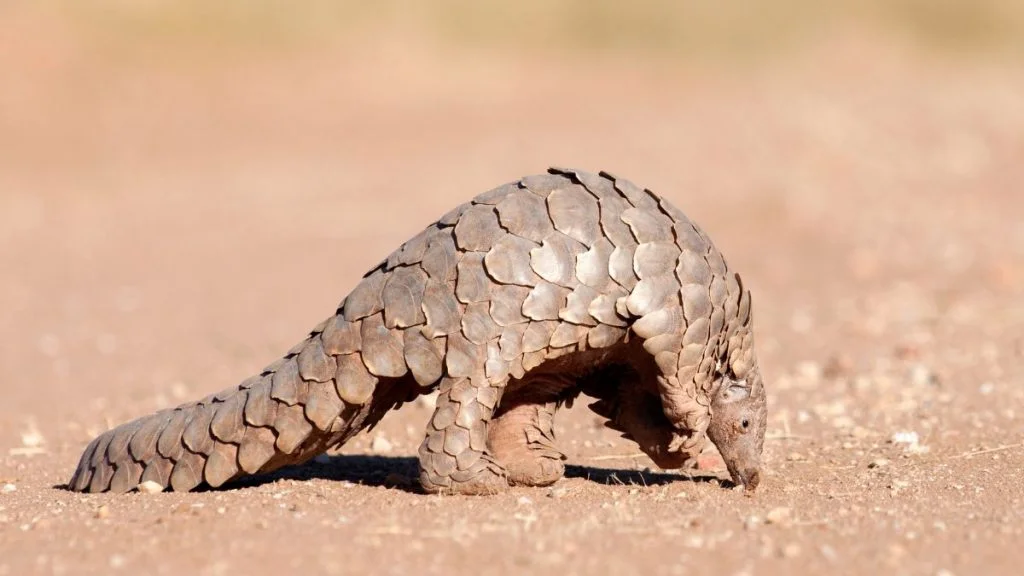Pangolins may not receive the same level of attention as lions and other popular wildlife.
Still, they are well known, especially for the hard, plate-like scales covering their bodies.
These scaly mammals have eight extant species scattered throughout Asia and Africa.
Sadly, many people in these areas hunt pangolins as food, contributing to their rank as the most trafficked mammal in the world.1
Amidst the challenges pangolins face, understanding their diet and eating habits can help us better understand their ecological roles and conservation needs.
So, what do pangolins eat?
In this article, we will explore pangolins’ diet and other facts about their eating habits and role in the ecosystem.
A Closer Look at Pangolin Diet and Their Eating Habit

Pangolins are carnivorous insectivores (insect-eaters), much like anteaters (Vermilingua).
In fact, their preference for ants and other insects has earned them the nickname “scaly anteaters.”
However, it’s worth noting that, despite their dietary similarities, pangolins are not closely related to anteaters.
Unlike most mammals, pangolins have anatomical modifications tailored to their specialized diet, including a complete lack of teeth.
Their tongue and stomach are also adapted to capture, eat, and digest insects.
What Do Pangolins Eat?

Pangolins have an insect-based diet comprising various insect species, including ants and termites.
They prefer hunting these insects since they have centralized nests and large numbers, thereby playing a crucial role in controlling these insects’ populations.2
On a typical day, pangolins may consume from 140 to 200 grams of insects, amounting to around 200,000 insects.
Pangolins skillfully use a scent-based foraging technique to find insects, making up for their poor vision.
Remarkably, pangolins also feed on insect larvae, an important nutritional source, especially for arboreal species.
Where Do Pangolins Find Food?
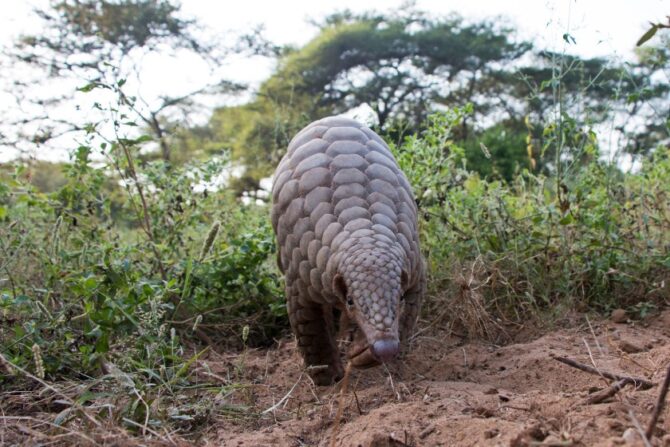
While all pangolin species are insectivorous, their feeding habits differ a little.
The same is true about their geographic range.
Arboreal pangolins dwell in trees, relying on tree branches for food and shelter.
In contrast, terrestrial pangolins live in underground burrows, which can be as deep as 11 feet (3.4 meters).
Terrestrial pangolins find their food underground, using their strong front legs to tear into termite mounds and dig the earth to hunt ants and termites.
Pangolins inhabit areas with large ant and termite populations, especially in areas near water sources.
These scaly animals thrive in various habitats, including thick bushes, tropical forests, cultivated and cleared areas, and grasslands.
How Do Pangolins Find Food?
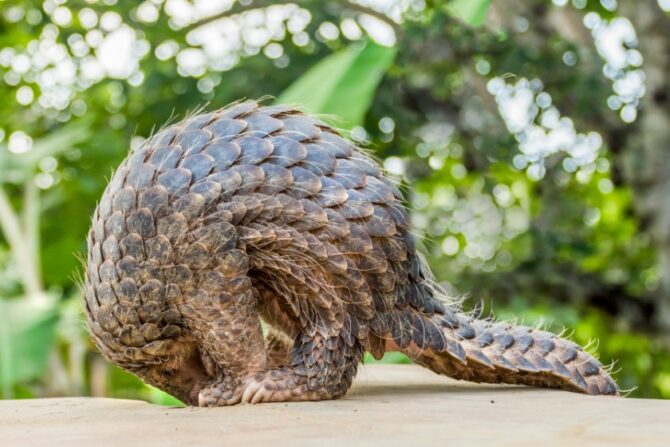
Pangolins are nocturnal animals with poor vision, relying instead on their excellent olfactory and hearing abilities to hunt even in the dead of night.
Their incredible sense of smell allows them to easily locate nests and hives underground or under tree barks.
Then, after finding them in stumps, mounds, fallen logs, and tree stems, these pangolins consume them with sticky tongues.
Pangolins may even dig burrows near termite anthills and mounds in search of a consistent food supply.
How Do Pangolins Eat?
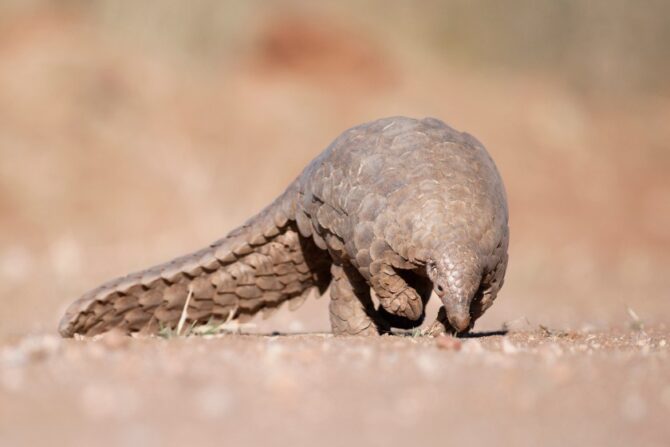
Pangolins are far from being among the most effective hunters, but they have biological adaptations for insect consumption.
They have long, flexible tongues that can extend into insect holes and tunnels to reach the insects.
Their tongue structure is crucial to their hunting prowess thanks to its clammy saliva coat that sticks ants and termites and keeps them in their mouth.
Although pangolins are mammals, they have a gizzard-like stomach common to birds that aid in digesting insects.3
Their stomachs can process the high chitinous diet of insects’ exoskeletal systems and other tough materials that make up insects’ bodies.
They also ingest small stones and bits of sand, which sit in their gizzards and help to grind their food.
Pangolins’ modification extends to other physical structures, including their skeletal strength and sturdy forelimbs.
They have sharp claws that complement their strong front limbs, which they use to break nests and hives.
Special muscles also seal their nostrils shut and protect them from sand and dust when eating.
Additionally, their scales prevent skin irritation in cases when insects fight back with bites and stings.
How Do Pangolins’ Feeding Habits Affect the Ecosystem?
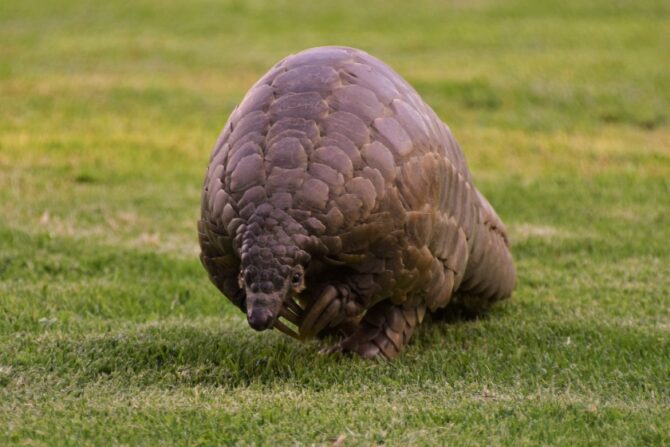
Pangolins contribute immensely to insect population control in the ecosystem, with one adult pangolin consuming around 70 million insects a year, equivalent to 200,000 insects daily.
Also, while searching for food and shelter, pangolins’ burrowing activity impacts soil processes by turning the organic matter over the earth’s surface and providing soil aeration.
This process helps modify the ecosystem by reworking soils, reducing soil compaction, increasing soil moisture, nutrient cycling, microbe diversity, carbon storage, and plant recruitment.
Losing pangolins to poaching could have devastating effects on their ecosystems, which is why they must be protected.
Frequently Asked Questions
What Are Some Facts about the Pangolin Diet?
Pangolins are insectivores with an insect-based diet comprising various ant and termite species and an assortment of insect larvae.
What Are the Dietary Needs of a Pangolin?
Pangolins are called scaly anteaters because they prefer to feed on ants, termites, and larvae, all of which are highly nutritional.
Can Pangolins Bite?
Pangolins cannot bite, as they lack teeth.
Instead, they use their sticky tongue to grasp insects and swallow them, relying on their gizzard-like stomach to grind food.
Pangolins use their scales for self-defense, performing a cutting motion with their scales when threatened.
Are Pangolins Omnivores or Herbivores?
Pangolins are neither herbivores nor omnivores.
While they can be classified as carnivores, they do not have a meat-based diet.
Pangolins are insectivorous animals that primarily eat various ant and termite species.
However, they may enjoy other insects and their larvae.
Can Pangolins Eat Meat?
While pangolins are considered carnivores, they don’t hunt fish, birds, amphibians, reptiles, rodents, or other mammals.
They have a simple diet consisting mostly of ants, termites, and their larvae, although they may eat other insect species.
Wrapping Up
Pangolins are scaly creatures with specialized adaptations to thrive on their insectivorous diet.
Despite their nocturnal nature and poor eyesight, pangolins can easily detect their tiny prey using their incredible sense of smell and hearing.
So, the next time you find yourself wondering, “What do pangolins eat?”, remember that these fascinating animals prefer a diet of ants and termites.
They play a key role in maintaining the delicate balance of their ecosystems by controlling these insects’ populations and so should be protected at all costs.
References & Notes
Facts Sources:
- Pangolin guide: where they’re found, and why they’re the most trafficked animal in the world. DiscoverWildlife
- Transcriptomic analysis identifies genes and pathways related to myrmecophagy in the Malayan pangolin (Manis javanica). National Library of Medicine
- A comparative morphometric analysis of the stomach in rat Rattus norvegicus, Bat Eidolon helvum and pangolin Manis tricuspid. International Scholars Journal
